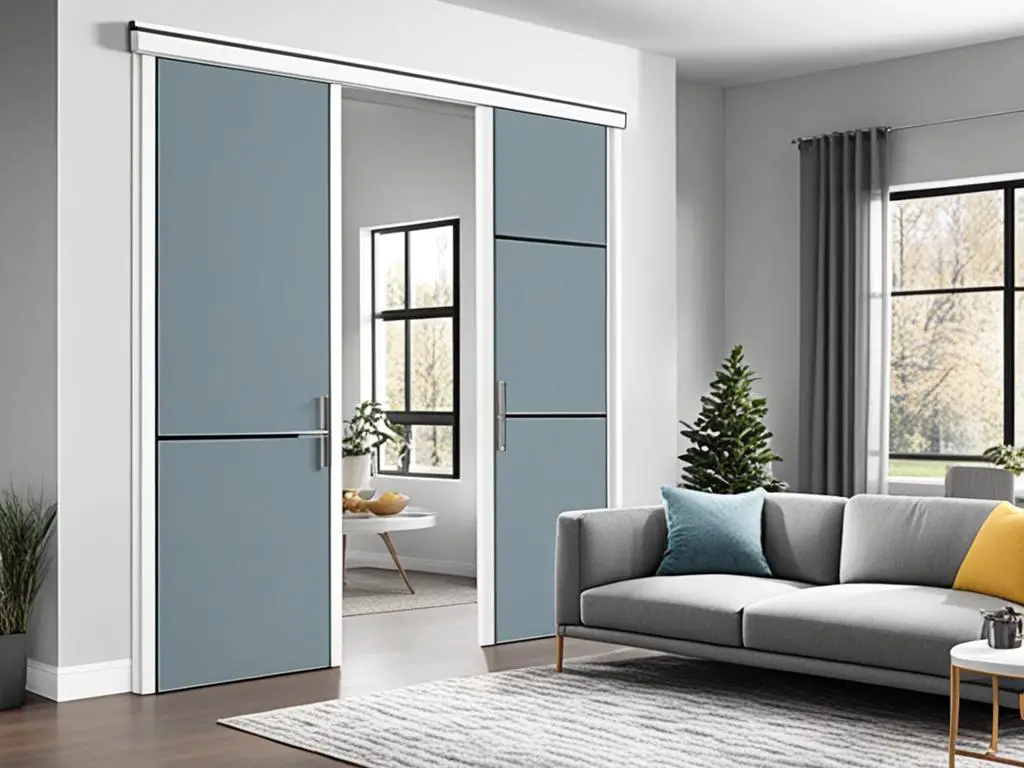When it comes to choosing interior doors, two popular options to consider are MDF (medium density fiberboard) and wood. Both materials have their unique advantages and benefits, making the decision a bit challenging. In this article, we will explore the differences between MDF interior doors and wood doors, compare their advantages, and help you make an informed decision.
Key Takeaways:
- MDF doors are engineered wood products made by compressing hardwood or softwood fibers with resin and wax.
- Wood doors are made from solid wood or wood veneers, offering a more traditional and natural look.
- MDF doors are resistant to warping, provide smoother surfaces for painting, and offer better water resistance.
- Wood doors offer the beauty of real wood grain, come in various species and can be stained to enhance their natural beauty.
- MDF doors are more affordable than wood doors, making them a cost-effective choice.
Manufacturing Process
MDF doors are made through a precise manufacturing process that involves compressing wood fibers with resin and wax in a hot press. This process results in panels with a more uniform density compared to particleboard, ensuring strength, durability, and resistance to warping and cracking. Let’s take a closer look at how MDF doors are made.

Step 1: Wood Preparation
The manufacturing process begins with the delivery or preparation of wood chips. These wood chips are refined to ensure consistent size and quality, creating a base material for the MDF production.
Step 2: Drying and Blending
The refined wood chips undergo a drying process to remove excess moisture. The dried wood chips are then blended with resin and wax additives. This blending process ensures the wood fibers are evenly coated and bonded with the binding agents, enhancing the strength and durability of the final product.
Step 3: Mat Forming
The blended wood fibers are placed in a mat-forming machine, where they are spread out and aligned in a controlled manner. This mat-forming process ensures an even distribution of the wood fibers, creating a consistent surface and thickness throughout the MDF panel.
Step 4: Hot Pressing
The formed mat of wood fibers is placed in a hot press, where it is subjected to both heat and pressure. This combination of heat and pressure activates the resin and wax additives, causing them to bond and harden the wood fibers together. The hot pressing process takes place under precise conditions and time frames to ensure a strong and durable MDF panel.
Step 5: Finishing
After the hot pressing process, the MDF panels undergo finishing treatments such as sanding to achieve a smooth surface and precise dimensions. The panels are then cut into the desired sizes and shapes for the production of MDF doors.
The meticulous manufacturing process of MDF doors guarantees high-quality, reliable, and aesthetically pleasing interior doors. The resulting MDF panels offer consistent density, durability, and resistance to warping and cracking, making them an ideal choice for various applications.
Benefits of MDF Doors
MDF doors offer numerous advantages over traditional wood doors, making them a popular choice for interior applications. Whether you’re looking for durability, customization options, or cost-effectiveness, MDF doors have you covered.
1. Resistance to Warping and Smoother Finish
MDF doors are inherently resistant to warping, making them a reliable choice for areas with high humidity or temperature fluctuations. Unlike wood doors, which can absorb moisture and swell, MDF doors maintain their shape and structural integrity over time.
Additionally, MDF doors provide a smooth and even surface that is perfect for painting. The consistent density and texture of MDF allow for a flawless finish, ensuring that the paint adheres well and results in a professional look.
2. Customization and Versatility
One of the significant advantages of MDF doors is their high level of customization. MDF can be easily drilled, cut, and routed without the risk of splintering or damaging the material. This flexibility allows for the creation of intricate designs, such as raised panels or decorative patterns, to match any architectural style or personal preference.
Moreover, MDF doors can seamlessly blend with other materials, such as glass or metal inserts, for added visual interest and functionality. Whether you’re aiming for a contemporary or traditional aesthetic, MDF doors provide endless possibilities.
3. Enhanced Water Resistance
Compared to wood doors, MDF doors offer better water resistance properties. This makes them an excellent choice for areas prone to moisture, such as bathrooms or kitchens. MDF doors provide peace of mind, knowing that they won’t absorb moisture or develop unsightly warping or mold growth.
4. Affordable Alternative
If budget is a consideration, MDF doors are a cost-effective solution. They provide the strength and durability of solid wood doors at a more affordable price point. With MDF doors, you can achieve the desired aesthetic and performance without breaking the bank.
5. Ease of Installation and Maintenance
Installing MDF doors is a straightforward process that doesn’t require specialized tools or expertise. They are lighter than solid wood doors, making handling and installation easier and more convenient.
Maintenance is also hassle-free with MDF doors. Their smooth surface is easy to clean and doesn’t require regular upkeep or refinishing like wood doors. This saves both time and money in the long run.
6. Environmentally Friendly and Fire-Retardant
For those concerned about the environment, MDF doors offer a sustainable choice. They are manufactured from recycled wood fibers, reducing waste and promoting responsible forest management.
Additionally, MDF doors can be made fire-retardant, providing an extra layer of safety and protection in the event of a fire.

| Benefits of MDF Doors | Benefits of Wood Doors |
|---|---|
| Resistance to warping | Natural and traditional look |
| Smoother finish for painting | Beauty of real wood grain |
| Highly customizable | Wide range of wood species and aesthetic options |
| Better water resistance | Can be stained for enhanced beauty |
| Affordable alternative | Solid and sturdy construction |
| Easy installation and maintenance | Biodegradable and renewable |
| Environmentally friendly | |
| Fire-retardant options available |
Benefits of Wood Doors
Wood doors offer numerous advantages that make them an excellent choice for interior doors. With their natural beauty and versatility, wood doors can enhance the aesthetics of any space. Here are some key benefits of choosing wood interior doors:
Diverse Aesthetics:
Wood doors are available in a wide range of wood species, including walnut, cherry, oak, and mahogany. Each species has its unique grain pattern and color, allowing homeowners to select doors that perfectly complement their interior design style and personal preferences.
Natural Beauty:
One of the most significant advantages of wood doors is their natural beauty. With their authentic wood grain, these doors bring warmth and character to any room. They can be stained or painted to highlight the natural beauty of the wood, creating a rich and inviting atmosphere.
Strength and Durability:
Wood doors offer exceptional strength and durability, making them a long-lasting investment. Solid wood doors are sturdy and resistant to everyday wear and tear, ensuring they will withstand the test of time. This durability provides homeowners with peace of mind, knowing their doors will continue to look and perform well for years to come.
Environmentally Friendly:
Choosing wood doors also aligns with eco-conscious choices. Wood is a renewable resource, making it an environmentally friendly option. Additionally, wood doors are biodegradable, reducing their impact on the environment throughout their lifespan. By selecting wood doors, homeowners can contribute to sustainable living.
Wood doors bring natural beauty, strength, and environmental benefits to any space, creating a timeless and inviting atmosphere.
In conclusion, wood doors offer numerous advantages that make them an excellent choice for interior door installations. Their diverse aesthetics, natural beauty, strength, and environmental-friendly nature are all compelling factors to consider. By choosing wood doors, homeowners can enjoy the timeless elegance and durability that these doors bring to their living spaces.
Cost Comparison
When it comes to choosing between MDF interior doors and wood doors, cost is a significant factor for many homeowners. Let’s explore the price comparison of MDF and wood doors to help you make an informed decision.
MDF Interior Doors
MDF doors are known for their affordability. Compared to wood doors, MDF doors generally have a lower cost, making them an attractive option, especially for budget-conscious individuals. The exact pricing may vary depending on factors such as the quality of construction and design, but overall, MDF doors offer a cost-effective solution without compromising on durability and functionality.
Wood Interior Doors
Wood doors, particularly those made from high-quality solid species wood, can be more expensive compared to MDF doors. The natural beauty and superior quality of wood contribute to its higher price point. However, it’s important to note that there are affordable wood door options available, such as engineered wood doors with veneers. These options provide the aesthetic appeal of wood at a more budget-friendly price.
When comparing the cost of MDF and wood doors, it’s essential to consider your budget and the desired look and feel for your interior doors. While MDF doors offer affordability, wood doors provide a classic and natural aesthetic that may be worth the higher price for some homeowners.
To help you visualize the price comparison, here’s a simple table:
| MDF Interior Doors | Wood Interior Doors |
|---|---|
| Lower cost | Varies based on wood species and construction |
| Resistant to warping and cracking | Natural beauty and quality |
| Smooth finish for painting | Can be stained to enhance wood grain |
Remember, the cost comparison is just one aspect to consider when choosing between MDF and wood doors. It’s important to also evaluate factors like durability, style, and personal preferences to make the right decision for your home.

Conclusion
When it comes to choosing the right interior door material, the decision between MDF and wood doors can be a tough one. Both options have their own unique advantages and considerations to weigh.
MDF doors offer practical benefits such as resistance to warping and moisture, making them a durable choice for areas prone to humidity. They also provide a smooth surface that is ideal for painting, allowing for customization and versatility in design. Additionally, MDF doors are often more affordable, making them a cost-effective option for homeowners on a budget.
On the other hand, wood doors exude a timeless and natural beauty that can enhance the overall aesthetic of a home. With the richness of real wood grain and the option to stain them in various shades, wood doors add warmth and elegance to any space. While they may require more maintenance and care, wood doors are known for their durability and solid construction.
In the end, the final decision on whether to choose MDF or wood doors ultimately depends on individual needs, budget, and the desired look and feel of the home. Consider factors such as durability, style, cost, and personal preferences to make the right choice. Whether it’s the practicality and affordability of MDF or the timeless beauty of wood, both options can provide a stylish and functional addition to your interior décor.
FAQ
What are the differences between MDF interior doors and wood doors?
MDF doors are made from engineered wood product, while wood doors are made from solid wood or wood veneers. MDF doors offer a smoother finish and resistance to warping, while wood doors provide a more traditional and natural look with real wood grain options.
What are the advantages of MDF interior doors?
MDF doors are resistant to warping, cracking, and moisture. They offer a smoother surface for painting, are highly customizable, and can be made fire-retardant. MDF doors are also more cost-effective compared to wood doors.
What are the benefits of wood interior doors?
Wood doors provide a traditional and natural look with the beauty of real wood grain. They are available in various species, can be stained to enhance their natural beauty, and are solid and sturdy. Wood doors are also biodegradable and renewable, making them an environmentally friendly choice.
How do the costs of MDF interior doors compare to wood doors?
MDF doors are generally more cost-effective compared to wood doors. While both materials have different price points based on construction and design, MDF doors are a more affordable option, especially for those on a budget. However, there are also more affordable wood door options available, such as engineered wood doors with veneers.
How do I choose the right interior door material?
When choosing between MDF and wood interior doors, consider factors such as durability, style, cost, and personal preferences. MDF doors are ideal for those seeking a smooth finish and resistance to warping, while wood doors offer a traditional and natural look with real wood grain options. Ultimately, the decision depends on individual needs, budget, and the desired aesthetic for the home.
What is the final decision on MDF vs wood doors?
The final decision on whether to choose MDF or wood doors depends on individual preferences and requirements. MDF doors offer advantages such as resistance to warping and moisture, a smooth surface for painting, and affordability. On the other hand, wood doors provide a traditional and natural look with the beauty of real wood grain and the option for staining. Consider your needs, budget, and desired aesthetic to make the best choice.



